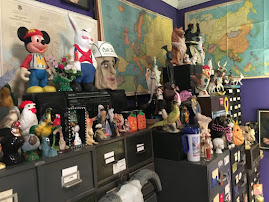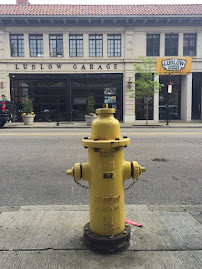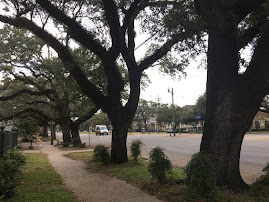Dear George,
In honor of Labor Day, I
thought I would post the lyrics of “Rosie the Riveter”. We identify
Rosie, of course, as the iconic image of women defense workers in World War
II. The original “We Can Do It” poster (above) was created in 1942 by a
Westinghouse Company artist, J. Howard Miller, in response to the federal
government’s urging industries to encourage more women to join the wartime work
force. Miller’s poster, however, had no association with the name “Rosie”
when it appeared, nor with the riveter occupation. Rather the name,
“Rosie the Riveter”, first appeared as the title of a song composed quite
independently by Redd Evans and John Jacob Loeb and released in early
1943. Recorded by the Kay Kaiser band among others, the song quickly
became a national hit. Here’s how it went:
ROSIE THE RIVETER
All the day long, whether
rain or shine
She's a part of the
assembly line
She's making history,
working for victory
Rosie, brrrrrrrrrrr, the
riveter
Keeps a sharp lookout for
sabotage
Sitting up there on the
fuselage
That little frail can do
more than a male can do
Rosie, brrrrrrrrrrr, the
riveter
Rosie's got a boyfriend,
Charlie
Charlie, he's a Marine
Rosie is protecting Charlie
Workin' overtime on the
riveting machine
When they gave her a
production 'E'
She was as proud as a girl
could be
There's something true
about, red, white, and blue about
Rosie, brrrrrrrrrrr, the
riveter
Doo-doo-doo-doo
Ev'ryone stops to admire
the scene
Rosie at work on the P-19
She's never twittery,
nervous or jittery
(FEMALE VOICE: I'm Rosie,
hm-hm-hm-hmm, the riveter)
What if she's smeared full
of oil and grease
Doin' her bit for the old
lend-lease
She keeps the gang around,
they love to hang around
Rosie (Hm-hm-hm-hm, that's
me, the riveter)
Rosie buys a lot of War
Bonds
That girl really has sense
Wishes she could purchase
more Bonds
Putting all her extra cash
in National Defense
Oh, when they gave her a
production 'E'
She was as proud as a girl
could be
There's something true
about, red, white, and blue about
Rosie the riveter gal
While other girls attend
their favorite cocktail bar
Sipping dry Martinis,
munching caviar
There's a girl who's really
putting them to shame
Rosie is her name
Oh, Rosie buys a lot of War
Bonds
That girl really has sense
Wishes she could purchase
more Bonds
Putting all her extra cash
into National Defense
Oh, Senator Jones, who was
in the know
Shouted these words on the
radio
Berlin will hear about,
Moscow will cheer about
Rosie
(Hah-hah-hah-hee-hee-hee), Rosie (Hee-hee-hee-hee)
Rosie the riveter gal (3)
A few months after Evans
and Loeb’s hit song appeared, Norman Rockwell created a cover for the May 29,
1943, issue of the Saturday Evening Post which featured a woman riveter with
the name Rosie on her lunchbox. Historians speculate that Rockwell was
familiar with Evans and Loeb’s song when he composed the picture. Rosie
is a large, muscular women wearing blue work clothes and holding a riveting gun
in her lap. A copy of Hitler’s Mein Kamp is under her feet, symbolizing Rosie’s contribution
to crushing the Nazi war machine. The American flag in the background
contributes to the patriotism of the message. (5)
Because of its massive
distribution, Rockwell’s Saturday Evening Post image was well-known at the time
and was widely used in war bond drives. However, because of copyright
restrictions, it was seen less and less often after the war ended.
Miller’s “We Can Do It” image was essentially unknown, having been shown only
to Westinghouse employees, and it disappeared within weeks. It was
rediscovered in the 1980s, became associated with the feminist movement, and
only then became linked to the label “Rosie the Riveter.”
With widespread enlistment
of males in the military in the early 1940s, women entered the American
workforce in unprecedented numbers. The female percentage of the U.S.
workforce increased from 27% to nearly 37% between 1940 and 1945. By 1944
4.1 million unmarried women between the ages of 20 and 34 worked in the defense
industry, compared to only 1.7 million unmarried men between those ages.
The aviation industry saw the largest increases for women. While women
constituted one percent of the aviation workforce before the war, over 310,000
women were employed by the aircraft industry in 1943, making up 65% of the
total workforce. In addition to factory work and other jobs, 350,000
American women joined the U.S. military, serving at home and abroad. (1)
(5)
In my home town the largest
industry in the 1940s was the Lloyd Loom factory which produced baby carriages
and wicker furniture. 250 male employees left Lloyd to join the military
at the war’s beginning, and they were replaced by local women, many new to the
work force. 85% of the Lloyd plant’s work was in war production: glider
fuselages, bomber trainers, airplane motor mounts, and high-explosive
shells. I like to think that Rosie the Riveter might have been a part of
the crew. (4)
Love,
Dave





















































































































































No comments:
Post a Comment